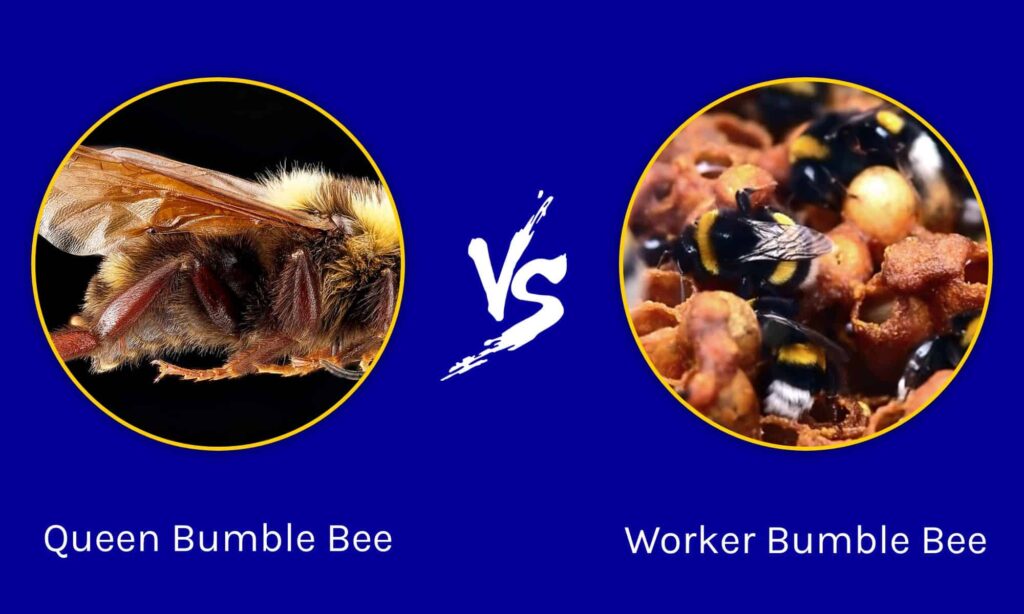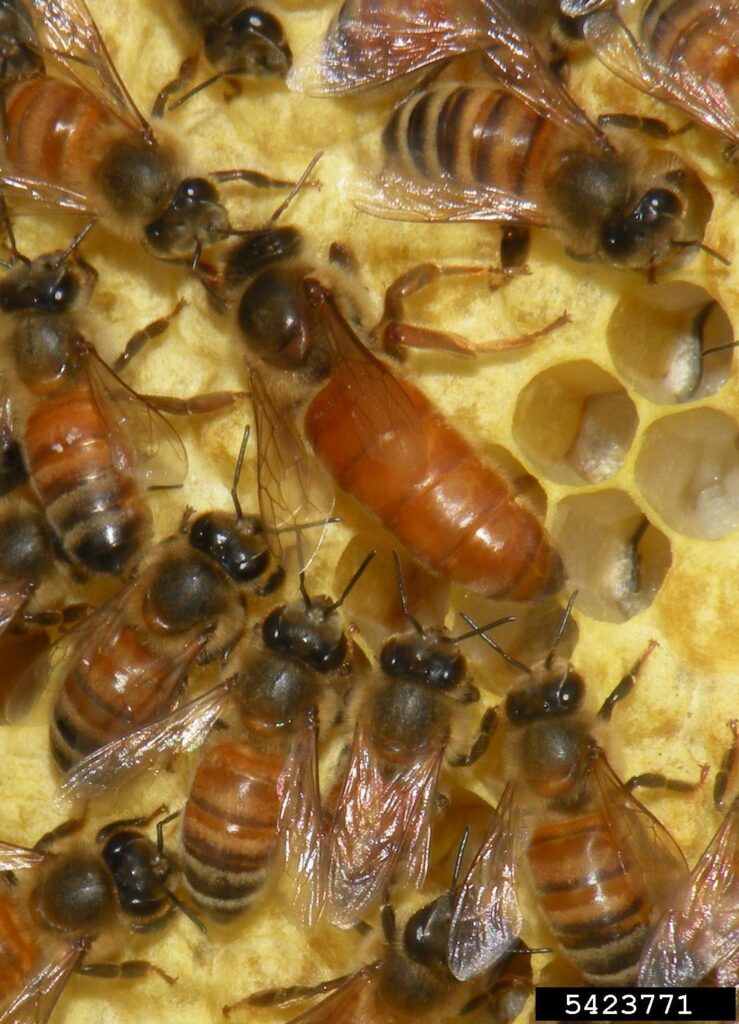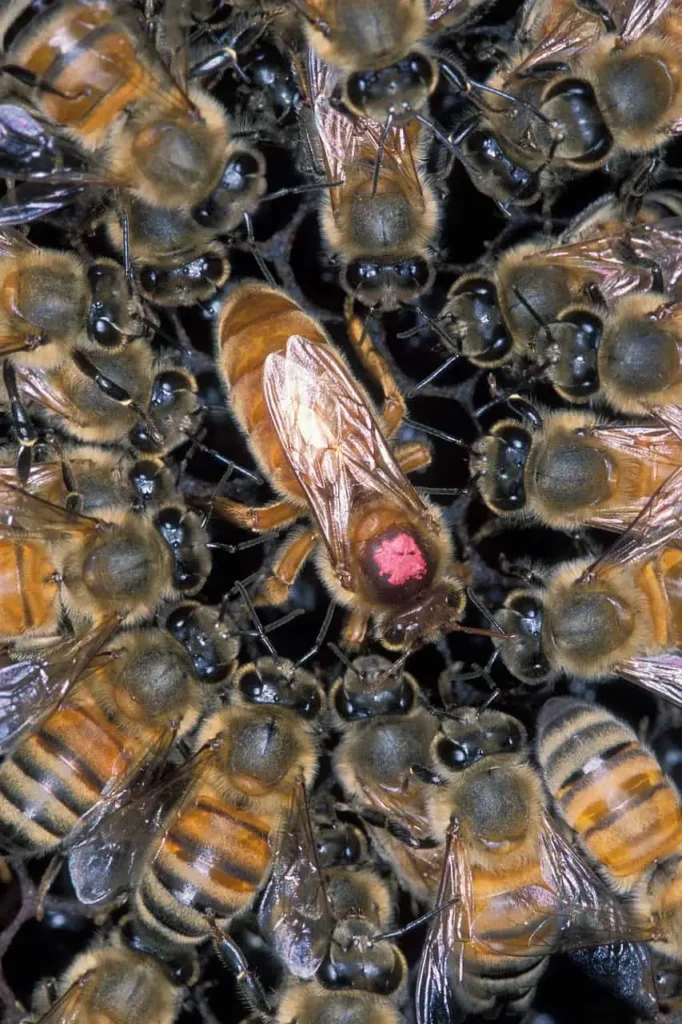
Have you ever wondered what sets a queen bee apart from a worker bee? Well, let’s buzz right into it! Although they may appear quite similar in appearance, queen bees and worker bees play vastly different roles within a beehive. From their size and lifespan to their reproductive capabilities, the distinctions between these two remarkable creatures are truly fascinating. So, join us as we explore the captivating world of queen bees and worker bees, shedding light on the vital functions they perform within a buzzing beehive.
Physical Differences
Size
The most noticeable physical difference between a queen bee and a worker bee is their size. The queen bee is significantly larger than the worker bee. On average, a queen bee can measure up to 1.5 inches in length, while a worker bee typically ranges from 0.3 to 0.5 inches. This size difference is important as it helps to distinguish the two roles within the colony.
Color
Another physical difference between the queen bee and the worker bee is their coloration. The queen bee is usually a darker shade, often appearing nearly black or dark brown. In contrast, worker bees are typically lighter in color, ranging from yellowish-brown to golden hues.
Abdomen
The abdomen of a queen bee and a worker bee also exhibit notable differences. The abdomen of the queen bee is larger and more elongated compared to the compact and rounded abdomen of the worker bee. The queen bee’s extended abdomen allows her to carry a larger number of eggs, which is fundamental to her reproductive role.
Wings
While both queen bees and worker bees have wings, there are noticeable differences in their wing structure. Queen bees have shorter wings in proportion to their body size. This is because their primary role is to reproduce and not engage in extensive foraging or other physical activities like worker bees. On the other hand, worker bees have larger and stronger wings as they perform numerous tasks such as foraging for food, building the hive, and protecting the colony.
Reproductive Abilities
Queen Bee
The queen bee is the primary reproductive individual in the colony. She is responsible for laying all the eggs that will lead to the growth and survival of the colony. A queen bee possesses both functional ovaries and a specialized reproductive structure called the spermatheca. This spermatheca allows her to store sperm received from the mating flight and use it to fertilize eggs throughout her lifespan. This unique reproductive ability enables the queen bee to maintain and sustain the entire population of the colony.
Worker Bee
In contrast to the queen bee, worker bees are female bees that are sterile and incapable of reproduction. Worker bees possess undeveloped ovaries, making them unable to lay eggs. While they are genetically capable of reproducing, the presence of the queen bee and the pheromones she emits suppresses their reproductive ability. The worker bees’ role is directed towards tasks such as foraging, caring for the brood, building and maintaining the hive, and protecting the colony.

Lifespan
Queen Bee
The queen bee’s lifespan is impressive compared to that of the worker bee. On average, a queen bee can live for several years, with some exceptional cases surpassing five years. This extended lifespan is primarily due to the controlled and protected environment provided within the hive. The queen bee is carefully taken care of by the worker bees, receiving constant nourishment and attention, which contributes to her longevity.
Worker Bee
The lifespan of a worker bee, in contrast to the queen bee, is relatively short-lived. A worker bee’s life spans on average from six to eight weeks, although some worker bees may live slightly longer depending on the seasonal demands of the hive. The demanding tasks that worker bees undertake, such as foraging, hive maintenance, and nursing the brood, result in a faster depletion of their energy reserves, ultimately leading to their shorter lifespan.
Roles and Responsibilities
Queen Bee
The primary role of the queen bee is reproduction. She lays eggs that will develop into the next generation of bees, ensuring the survival and growth of the colony. The queen bee also emits pheromones that regulate the behavior and development of the worker bees. Her presence is crucial for maintaining the social cohesion and organization within the hive. Additionally, the queen bee plays a vital role in colony reproduction through swarming, where a portion of the colony, including the queen, leaves to establish a new hive.
Worker Bee
Worker bees are highly industrious and assume a variety of roles and responsibilities within the colony. They are responsible for tasks such as foraging for nectar and pollen, building and repairing the hive, nursing and caring for the brood, and defending the hive from potential threats. Worker bees also regulate the internal environment of the hive, controlling temperature and humidity levels. Their responsibilities change as they age, with younger worker bees typically focusing on tasks within the hive and older worker bees venturing out for foraging.

Social Hierarchy
Queen Bee
Within the colony’s social hierarchy, the queen bee reigns supreme. She is the most revered and essential individual in the hive. The queen bee’s presence and dominance are maintained through the pheromones she emits. Her scent communicates her status and reproductive capability, reinforcing her authority over the worker bees.
Worker Bee
Worker bees are the majority in the colony and fulfill various roles based on their age. Their social hierarchy is structured in an efficient and organized manner. While they have a well-defined division of labor, their roles are not fixed. Worker bees can transition between tasks depending on the immediate needs of the colony. The hierarchy among worker bees is determined by factors such as age and specialization in specific tasks.
Nutrition and Diet
Queen Bee
The queen bee has a distinctive diet compared to the worker bees. While worker bees primarily consume nectar and pollen, the queen bee’s diet includes these floral resources as well as a specialized substance called royal jelly. Royal jelly, a secretion produced by worker bees, is rich in proteins and fatty acids, providing essential nutrients for the queen bee’s development and reproductive function. The exclusive consumption of royal jelly during her larval stage sets the queen bee apart from other bees.
Worker Bee
Worker bees rely on a diverse diet to fulfill their energy requirements. The primary components of their diet are nectar and pollen. Nectar serves as their main source of carbohydrates, providing the energy needed for their daily activities. Pollen, on the other hand, is rich in proteins, amino acids, and essential nutrients. Worker bees collect pollen and bring it back to the hive, where it is used both as a food source and for the production of royal jelly, which is fed to the developing larvae.

Ability to Sting
Queen Bee
Although the queen bee possesses a stinger, her ability to sting is comparatively limited. The queen bee’s stinger is smooth and does not have barbs like the worker bees’ stingers. As a result, the queen bee can sting multiple times without losing her stinger. However, the queen bee’s primary focus is on reproduction rather than defense, so she rarely stings other bees or potential threats.
Worker Bee
Worker bees have a well-known ability to sting, and their stinging mechanism is highly effective in defending the hive. The worker bee’s stinger is barbed, which means that once it is used, it becomes lodged in the target, resulting in the loss of the stinger and, ultimately, the death of the worker bee. This self-sacrificial act of stinging is a defense mechanism against predators and intruders, aiming to protect the hive and its inhabitants.
Production of Pheromones
Queen Bee
Pheromones play a vital role in communication and organization within the hive, and the queen bee is the primary source of these chemical signals. The queen bee produces an array of pheromones, including the queen mandibular pheromone and the queen retinue pheromone. These pheromones act as signals to maintain social cohesion, regulate the behavior of worker bees, inhibit worker bee reproduction, and attract potential mates during mating flights.
Worker Bee
While worker bees do not produce as many pheromones as the queen, they have their own set of chemical signals that contribute to the overall communication within the colony. Worker bees produce alarm pheromones in response to threats or disturbances, which warn other worker bees and activate defensive responses. They also produce scent marks during foraging, helping other worker bees locate nectar sources and navigate back to the hive.

Mating Behavior
Queen Bee
The mating behavior of the queen bee is a remarkable process involving a mating flight and multiple matings. On her mating flight, the queen bee mates with numerous drones from other hives, collecting a sufficient amount of sperm in her spermatheca. Once she has mated, the queen bee returns to her hive and does not engage in any further mating activities for the rest of her life.
Worker Bee
Worker bees do not engage in mating behavior and remain sterile their entire lives. They are responsible for caring for the brood and supporting the queen bee in her reproductive tasks. The worker bees’ loyalty and dedication to the queen bee and the colony are central to their survival and the success of the entire hive.
Function in the Colony
Queen Bee
The primary function of the queen bee is to ensure the survival and growth of the colony through the production of offspring. She is solely responsible for laying eggs, which will develop into worker bees, drones, and potential future queen bees. The queen bee’s capacity to produce a large number of eggs and regulate the behavior of worker bees ensures the colony’s long-term sustainability.
Worker Bee
Worker bees fulfill a multitude of functions within the colony. Their roles include foraging for nectar and pollen, building and maintaining the hive, nursing and caring for the brood, regulating hive temperature, defending the colony against predators, and communicating vital information through chemical signals. Their collective efforts and division of labor contribute to the smooth functioning and productivity of the colony as a whole.
In conclusion, queen bees and worker bees differ significantly in their physical characteristics, reproductive abilities, lifespan, roles and responsibilities, social hierarchy, nutrition and diet, ability to sting, production of pheromones, mating behavior, and function within the colony. These differences highlight the specialized adaptations and division of labor necessary for the survival and success of the bee colony. Each bee’s unique qualities contribute to the overall harmony and efficiency within the intricate social structure of the hive.
